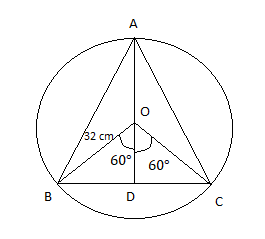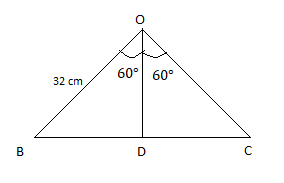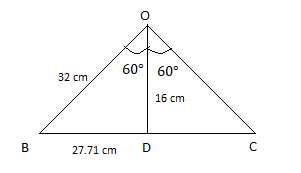
In a circular table corner of radius $32{\text{ cm}}$. A design is formed leaving an equilateral $\Delta ABC$ in the middle as shown in fig. Find the area of the design.


Answer
576.6k+ views
Hint: We have to find the area of the design. For that, we need to find the area of the circle and area of the equilateral triangle.
The area of the circle we can find by using direct formula.
For finding the area of the equilateral triangle, we have to know the length of the side.
Then, \[{\text{The area of the design is = Area of the circle - The area of the equilateral triangle}}\].
Using this formula we can get our final answer.
Complete step-by-step answer:

It is given that; the radius of the circular table is \[32\] cm. The design of the table formed an equilateral triangle. We have to find the area of the design.
\[{\text{The area of the design is = Area of the circle - The area of the equilateral triangle}}\]
So, we have to find the area of the circle and the area of the equilateral triangle.
Area of the circle:
We know that, if the radius of a circle is \[r\], the area of the circle is \[\pi {r^2}\].
Substitute, \[r = 32,\pi = 3.14\] in the general formula of the area of the circle we get,
The area of the circle is \[3.14 \times 32 \times 32\] sq. cm.
Simplifying we get,
The area of the circle is \[3215.36\] sq. cm.
Area of the equilateral triangle:
At first, we will find the side of the equilateral triangle.
Consider,

From the triangle \[\Delta BOD\] we get,
\[ \Rightarrow \dfrac{{BD}}{{BO}} = \sin {60^ \circ }\]
Substitute the values we get,
\[ \Rightarrow BD = 32\sin {60^ \circ }\]
Simplifying we get,
\[\therefore BD = 27.71\] cm
So, \[BC = 2BD = 2 \times 27.71 = 55.43\] cm
Again,
\[ \Rightarrow \dfrac{{OD}}{{BO}} = \cos {60^ \circ }\]
Substitute the values we get,
\[ \Rightarrow OD = 32\cos {60^ \circ }\]
Simplifying we get,
\[\therefore OD = 16\] cm

We know that, the area of any triangle is
\[ \Rightarrow \dfrac{{\text{1}}}{{\text{2}}}{{\times base \times perpendicular}}\].
So, the area of the triangle \[\Delta BOC\] is,
\[ \Rightarrow \dfrac{1}{2} \times 16 \times 55.43\] sq. cm
Simplifying we get,
The area of the triangle \[\Delta BOC\] is,
\[ \Rightarrow 443.4\] sq. cm
Therefore, the area of the equilateral triangle \[\Delta ABC\] is,
\[ \Rightarrow 3 \times 443.4\] sq. cm
Simplifying we get,
The area of the equilateral triangle \[\Delta ABC\] is,
\[ \Rightarrow 1330.2\] sq. cm
So, the area of shaded region \[ = 3215.36 - 1330.2 = 1885.16\] sq. cm
Hence, the area of the shaded part is \[1885.16\] sq. cm.
Note: Like this problem converting the question into a diagram is easy to understand and updating the data that we find in the diagram will help us to find the required answer. We may go wrong on mentioning the angles in solution. Because we divide one triangle into three triangles, which we get confused about.
The area of the circle we can find by using direct formula.
For finding the area of the equilateral triangle, we have to know the length of the side.
Then, \[{\text{The area of the design is = Area of the circle - The area of the equilateral triangle}}\].
Using this formula we can get our final answer.
Complete step-by-step answer:

It is given that; the radius of the circular table is \[32\] cm. The design of the table formed an equilateral triangle. We have to find the area of the design.
\[{\text{The area of the design is = Area of the circle - The area of the equilateral triangle}}\]
So, we have to find the area of the circle and the area of the equilateral triangle.
Area of the circle:
We know that, if the radius of a circle is \[r\], the area of the circle is \[\pi {r^2}\].
Substitute, \[r = 32,\pi = 3.14\] in the general formula of the area of the circle we get,
The area of the circle is \[3.14 \times 32 \times 32\] sq. cm.
Simplifying we get,
The area of the circle is \[3215.36\] sq. cm.
Area of the equilateral triangle:
At first, we will find the side of the equilateral triangle.
Consider,

From the triangle \[\Delta BOD\] we get,
\[ \Rightarrow \dfrac{{BD}}{{BO}} = \sin {60^ \circ }\]
Substitute the values we get,
\[ \Rightarrow BD = 32\sin {60^ \circ }\]
Simplifying we get,
\[\therefore BD = 27.71\] cm
So, \[BC = 2BD = 2 \times 27.71 = 55.43\] cm
Again,
\[ \Rightarrow \dfrac{{OD}}{{BO}} = \cos {60^ \circ }\]
Substitute the values we get,
\[ \Rightarrow OD = 32\cos {60^ \circ }\]
Simplifying we get,
\[\therefore OD = 16\] cm

We know that, the area of any triangle is
\[ \Rightarrow \dfrac{{\text{1}}}{{\text{2}}}{{\times base \times perpendicular}}\].
So, the area of the triangle \[\Delta BOC\] is,
\[ \Rightarrow \dfrac{1}{2} \times 16 \times 55.43\] sq. cm
Simplifying we get,
The area of the triangle \[\Delta BOC\] is,
\[ \Rightarrow 443.4\] sq. cm
Therefore, the area of the equilateral triangle \[\Delta ABC\] is,
\[ \Rightarrow 3 \times 443.4\] sq. cm
Simplifying we get,
The area of the equilateral triangle \[\Delta ABC\] is,
\[ \Rightarrow 1330.2\] sq. cm
So, the area of shaded region \[ = 3215.36 - 1330.2 = 1885.16\] sq. cm
Hence, the area of the shaded part is \[1885.16\] sq. cm.
Note: Like this problem converting the question into a diagram is easy to understand and updating the data that we find in the diagram will help us to find the required answer. We may go wrong on mentioning the angles in solution. Because we divide one triangle into three triangles, which we get confused about.
Recently Updated Pages
Two men on either side of the cliff 90m height observe class 10 maths CBSE

What happens to glucose which enters nephron along class 10 biology CBSE

Cutting of the Chinese melon means A The business and class 10 social science CBSE

Write a dialogue with at least ten utterances between class 10 english CBSE

Show an aquatic food chain using the following organisms class 10 biology CBSE

A circle is inscribed in an equilateral triangle and class 10 maths CBSE

Trending doubts
Why is there a time difference of about 5 hours between class 10 social science CBSE

Write a letter to the principal requesting him to grant class 10 english CBSE

What is the median of the first 10 natural numbers class 10 maths CBSE

The Equation xxx + 2 is Satisfied when x is Equal to Class 10 Maths

Which of the following does not have a fundamental class 10 physics CBSE

State and prove converse of BPT Basic Proportionality class 10 maths CBSE




